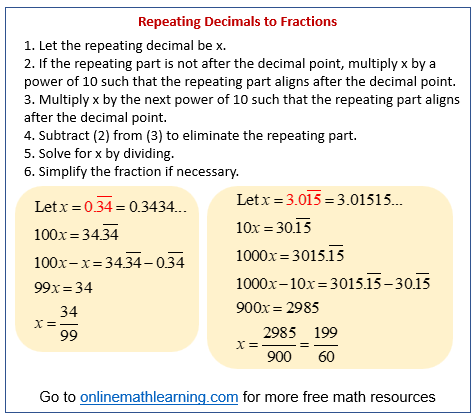Convert Repeating Decimals to Fractions
Related Topics:
Math Worksheets according to Topics
More Grade 6 Math Lessons
Grade 6 Math Worksheets
There are three sets of converting decimals worksheets.
Convert Decimals to Fractions
Convert Decimals to Mixed Numbers
Convert Repeating Decimals to Fractions
Examples, solutions, videos, and worksheets to help Grade 6 students learn how to repeating decimals to fractions. Include dividing decimals word problems.
How to convert a repeating decimal to a fraction?
There are several methods to convert repeating decimals to fractions. Here two common approaches:
Method 1: Algebraic Method
This method is more formal and works for all repeating decimals.
- Let x = the repeating decimal.
- Let n = the number of repeating digits.
- Multiply both sides of the equation in (1) by 10n.
- Subtract the equation from step (1) from the equation in step (3) to eliminate the repeating part.
- Solve for x, expressing your answer as a fraction in its simplest form.
Method 2: Shortcut for Simple Repeating Decimals
This method works when the repeating part starts immediately after the decimal point.
- Write the repeating digits as the numerator.
- Write a denominator with the same number of 9s as there are repeating digits.
- Simplify the fraction.
Example: Convert 0.121212… to a fraction
Numerator: 12
Denominator: 99 (two repeating digits)
Fraction: 12/99 = 4/33
Note:
- If the decimal has a non-repeating part before the repeating part (like 0.1666…), you’ll need to use the algebraic method.
- If there’s a whole number part (like 1.3434…), you can treat the decimal part separately and add it to the whole number at the end (1 + 34/99 = 133/99).
The following figure gives the steps for the algebraic method that will work for any repeating decimals.

Have a look at this video if you need to review how to convert repeating decimals to fractions.
Have a look at this video if you want to use a shortcut trick to convert repeating decimals to fractions.
Click on the following worksheet to get a printable pdf document.
Scroll down the page for more Convert Repeating Decimals to Fractions Worksheets.
More Convert Repeating Decimals to Fractions Worksheets
Printable
(Answers on the second page.)
Convert Repeating Decimals to Fractions #1 (1 repeating digit)
Convert Repeating Decimals to Fractions #2 (2 or more repeating digits)
Convert Repeating Decimals to Fractions #3 (repeating pattern with non-repeating digits)
Convert Repeating Decimals to Fractions #4 (mixed)
Online
Decimals to Fractions
Decimals to Mixed Numbers
Convert Repeating Decimals to Fractions Word Problem
- Samantha has a repeating decimal pattern of 0.333… as the result of a division. Express this decimal as a fraction.
-
Show Answer
1/3
-
Show Answer
Related Lessons & Worksheets
Convert Recurring Decimals to Fractions Lesson
Try out our new and fun Fraction Concoction Game.
Add and subtract fractions to make exciting fraction concoctions following a recipe. There are four levels of difficulty: Easy, medium, hard and insane. Practice the basics of fraction addition and subtraction or challenge yourself with the insane level.

We welcome your feedback, comments and questions about this site or page. Please submit your feedback or enquiries via our Feedback page.
